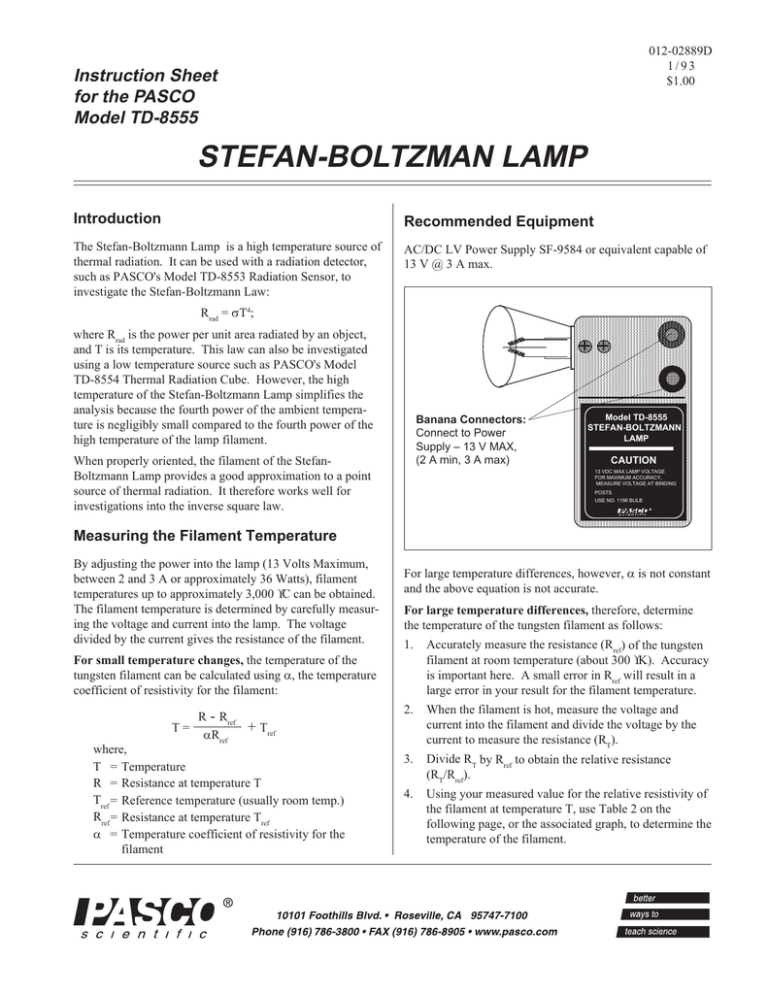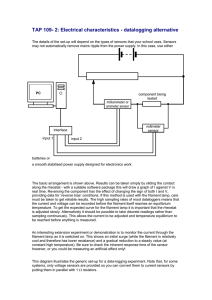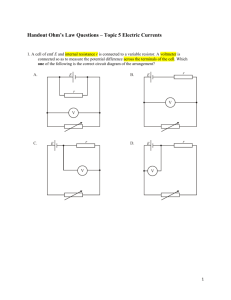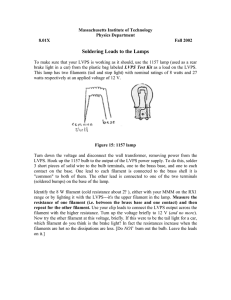STEFAN-BOLTZMAN LAMP
advertisement

012-02889D 1/93 $1.00 Instruction Sheet for the PASCO Model TD-8555 STEFAN-BOLTZMAN LAMP Introduction Recommended Equipment The Stefan-Boltzmann Lamp is a high temperature source of thermal radiation. It can be used with a radiation detector, such as PASCO's Model TD-8553 Radiation Sensor, to investigate the Stefan-Boltzmann Law: AC/DC LV Power Supply SF-9584 or equivalent capable of 13 V @ 3 A max. Rrad = σT4; where Rrad is the power per unit area radiated by an object, and T is its temperature. This law can also be investigated using a low temperature source such as PASCO's Model TD-8554 Thermal Radiation Cube. However, the high temperature of the Stefan-Boltzmann Lamp simplifies the analysis because the fourth power of the ambient temperature is negligibly small compared to the fourth power of the high temperature of the lamp filament. Banana Connectors: Connect to Power Supply – 13 V MAX, (2 A min, 3 A max) When properly oriented, the filament of the StefanBoltzmann Lamp provides a good approximation to a point source of thermal radiation. It therefore works well for investigations into the inverse square law. Model TD-8555 STEFAN-BOLTZMANN LAMP CAUTION 13 VDC MAX LAMP VOLTAGE FOR MAXIMUM ACCURACY, MEASURE VOLTAGE AT BINDING POSTS. USE NO. 1196 BULB Measuring the Filament Temperature By adjusting the power into the lamp (13 Volts Maximum, between 2 and 3 A or approximately 36 Watts), filament temperatures up to approximately 3,000 °C can be obtained. The filament temperature is determined by carefully measuring the voltage and current into the lamp. The voltage divided by the current gives the resistance of the filament. For large temperature differences, however, α is not constant and the above equation is not accurate. For large temperature differences, therefore, determine the temperature of the tungsten filament as follows: 1. Accurately measure the resistance (Rref) of the tungsten filament at room temperature (about 300 °K). Accuracy is important here. A small error in Rref will result in a large error in your result for the filament temperature. 2. When the filament is hot, measure the voltage and current into the filament and divide the voltage by the current to measure the resistance (RT). 3. Divide RT by Rref to obtain the relative resistance (RT/Rref). 4. Using your measured value for the relative resistivity of the filament at temperature T, use Table 2 on the following page, or the associated graph, to determine the temperature of the filament. For small temperature changes, the temperature of the tungsten filament can be calculated using α, the temperature coefficient of resistivity for the filament: T= R - Rref αRref + Tref where, T = Temperature R = Resistance at temperature T Tref = Reference temperature (usually room temp.) Rref = Resistance at temperature Tref α = Temperature coefficient of resistivity for the filament 012-02889D Limited Warranty Important: The voltage into the lamp should NEVER exceed 13 V. Higher voltages will burn out the filament. PASCO scientific warrants this product to be free from defects in materials and workmanship for a period of one year from the date of shipment to the customer. PASCO will repair or replace, at its option, any part of the product which is deemed to be defective in material or workmanship. This warranty does not cover damage to the product caused by abuse or improper use. Determination of whether a product failure is the result of a manufacturing defect or improper use by the customer shall be made solely by PASCO scientific. Responsibility for the return of equipment for warranty repair belongs to the customer. Equipment must be properly packed to prevent damage and shipped postage or freight prepaid. (Damage caused by improper packing of the equipment for return shipment will not be covered by the warranty.) Shipping costs for returning the equipment, after repair, will be paid by PASCO scientific. Replacement Bulb: Use GE Lamp No. 1196, available at most auto parts stores. When replacing the bulb, solder the leads to minimize resistance. Note: Complete instructions for the StefanBoltzmann and inverse square law experiments can be found in the Instruction Manual and Experiment Guide for the PASCO scientific Thermal Radiation System (PASCO Part NO. 012-02845). Temperature and Resistivity for Tungsten R/R 300K 1.0 1.43 1.87 2.34 2.85 3.36 3.88 4.41 4.95 Temp Resistivity µΩ cm °K 300 400 500 600 700 800 900 1000 1100 5.65 8.06 10.56 13.23 16.09 19.00 21.94 24.93 27.94 R/R 300K 5.48 6.03 6.58 7.14 7.71 8.28 8.86 9.44 10.03 Temp Resistivity µΩ cm °K 1200 1300 1400 1500 1600 1700 1800 1900 2000 R/R 300K 10.63 11.24 11.84 12.46 13.08 13.72 14.34 14.99 15.63 30.98 34.08 37.19 40.36 43.55 46.78 50.05 53.35 56.67 Temp Resistivity µΩ cm °K 2100 2200 2300 2400 2500 2600 2700 2800 2900 60.06 63.48 66.91 70.39 73.91 77.49 81.04 84.70 88.33 R/R 300K Temp Resistivity µΩ cm °K 16.29 16.95 17.62 18.28 18.97 19.66 26.35 3000 3100 3200 3300 3400 3500 3600 Temperature versus Resistivity for Tungsten 20 19 18 17 16 15 14 13 Relative Resistivity RT R 300K 12 11 10 9 8 7 6 5 4 3 2 1 0 0 500 1000 1500 2000 Temperature (Kelvin) 2 2500 3000 3500 92.04 95.76 99.54 103.3 107.2 111.1 115.0




